
219
3826

Aesthetics and the Racing Machine! A celebration at the Richard Mille Le Mans Classic!
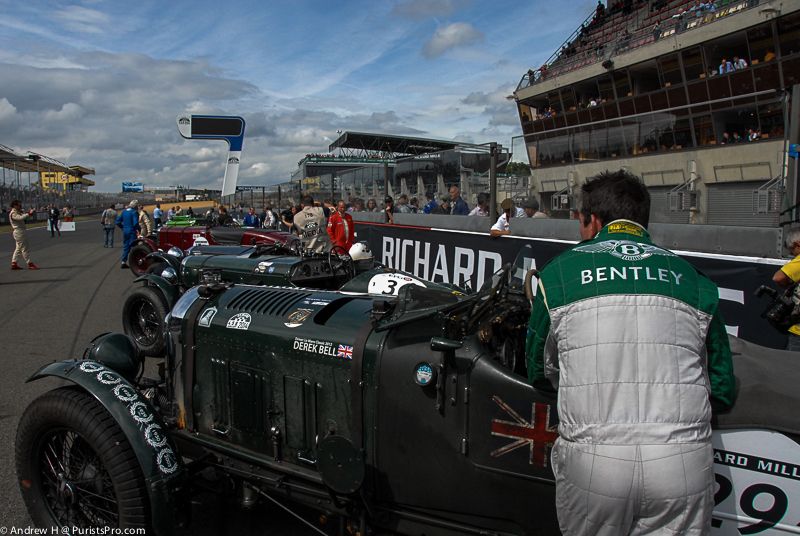

[The traditional start still applies for the correct era of racing]
I should probably warn most that this is a rather picture intensive post! With so many racing legends on the track, it was all too easy to get ‘trigger happy’ and take pictures of each and every car. The Le Mans Classic, now in its sixth running, has become something of a moving (and a high speed one at that) museum and display of the age of the racing automobile. Richard has been the sponsor since the start. It is where his watches started: influenced by racing car ideas of how both chassis and engine need to be designed together and not as separate units.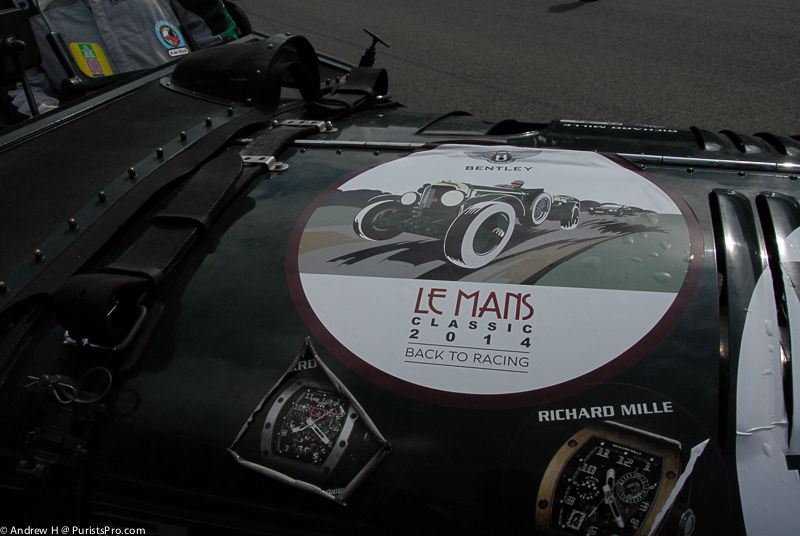
Richard has never made any secret of the fact that he drew his initial inspiration from motorcar racing. While the cross-over between watchmaking and motorcars has been made before, by a number of people (most notably George Daniels who simply put the differences down to the size of hammer used), Richard actually went one step further and introduced design, material, and manufacture techniques into the watch itself. This was not simply ‘sticking’ some material around a pre-existing movement, but designed case and movement as an integrated whole:
“This case expresses my love for technique in general, cars and aviation in particular… (A)s I wanted to create a very different object, extremely ergonomic with characteristic lateral ribs of improved rigidity, a large size and easy-to-grip hand setting crown, easy to read watch with clear numbers and anti glare treatment on sapphire glass. In total, an efficient, relentless watch, no gimmick, no glamour.”
For elements of the watch, Richard went further, and used some of the same ideas that aide car speed and safety into the watch:
“A lot of inspiration came to me from high performance automobiles, such as the shock resistance studies, improvement of the plate rigidity, mostly around the turning points, reduction of friction, easy access for the watchmakers. For example, the tourbillon bridge looks like a suspension triangle; …
At the back, all the ribs ensure a better rigidity for the bottom plate and bridge assembly, as you can find in a CART or F1 engine around the rotating elements.”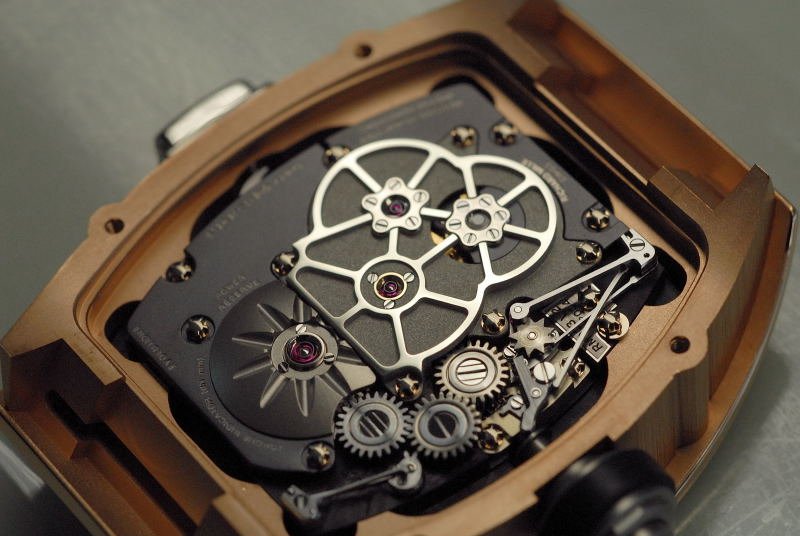
Richard actually saw similarities between the way the racing car was designed and assembled, and the watches he made:
“On the other hand, as in Formula 1, CART or IRL, my production is very limited, and everything is hand finished (movement blank, bevels, screws are hand polished, as well as locking sections, chamfers, lapped and polished ends, rolled pivots, circular-smoothed faces, etc..) … Nevertheless, this watch, as an F1 racer, also has the user’s facilities in mind and the reliability of a great GT car.”
“Of course, the aesthetics has its importance, but function has always been privileged. This is why the torque indicator and the function selector are directly inspired by the automotive industry. At the back, all the ribs ensure a better rigidity for the bottom plate and bridge assembly, as you can find in a CART or F1 engine around the rotating elements. … Another example is the time setting mechanism fitted against the case back: we have at the same time a practical approach and an aesthetic one...”
(http://www.thepurists.com/watch/features/interviews/MilleApr02/index.html)
Racing machines are fickle things: require patience (independent of the speed they might attain) to tune for the track. Their shape and design is borne from the need to increase their racing speed: a singular purpose.
[One of Colin Chapman’s earliest racing machines: a Lotus 17 at speed at the end of the Mulsanne straight. Chapman experimented with both metals: reducing the car’s weight; and aesthetics: making the car as streamlined as possible. His byline: “Simplify: and then add lightness!”]
Richard’s watch designs have evolved. While the racing philosophy is still ingrained in his watches, racing has diversified to take on a number of forms: sailing, athletics, and more recently, even skiing. But car racing remains Richard’s first and truest love. His enthusiasm undiminished, Richard still revels in the biannual holding of a racing festival that allows the ageing Le Mans cars of yesteryear race around track that was once their domain. Watching the racing gladiators of old duel it out of the track, it is worth considering what the aesthetics of racing machines can teach the watchmaking world and how we might assess Richard’s design and aesthetic contribution to the watch.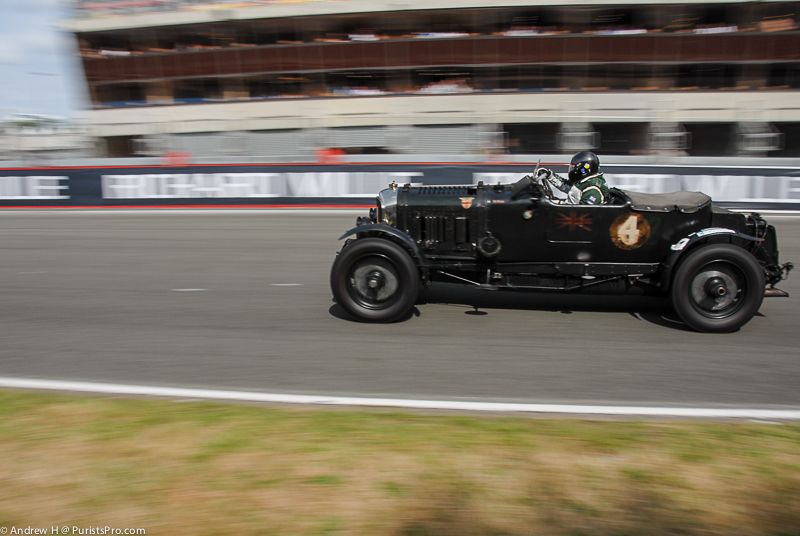
[A 1929 Bentley four and a half litre ‘blower’ speeds down the finishing straight]
In the early stage of motorcar design the design clues and architecture were adopted from the steam engine. It was the same basic design and function: a long bonnet, small cab and fuel tender. The recognizable sports car was just that: long bonnet, small cockpit and small boot. Bentley is perhaps the most recognizable form, and the most successful racing form on the Circuit de Sarthe. Bentley certainly dominated the race in the initial years; out of the first decade for the race, Bentley won half the races. They were that successful. It was, as Ettore Bugatti apparently said: the Bentley was the world’s fastest truck!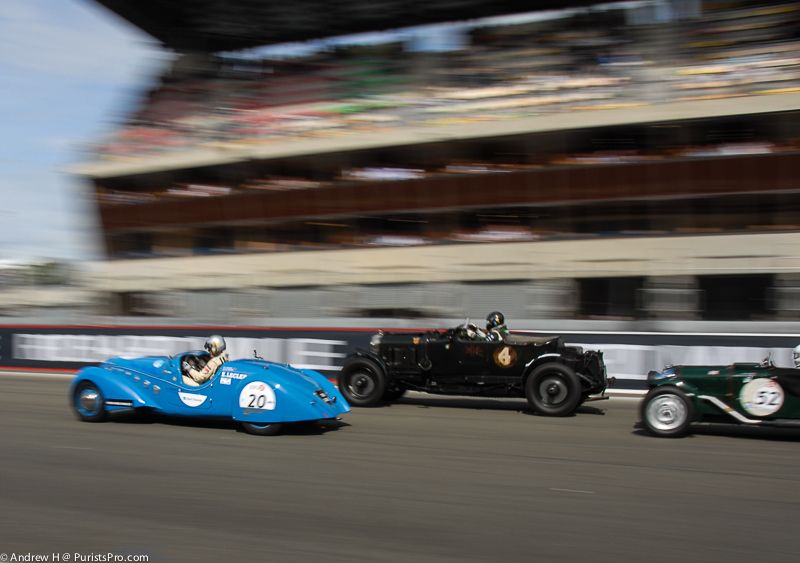
[The “world’s fastest truck” passes the Peugeot 402 Darl’mat and Morgan 4/4]
Success at racing comes from being able to harness knowledge and materials from other engineering fields. In Bentley’s case, he was one of the first to use what he had learned in aviation and locomotive fields. He helped develop engines in the First World War for airplanes that introduced aluminum pistons for saving weight and allowing higher compression ratios in the cylinders. Bentley carried such ideas into the design and manufacture of his cars. However, the aesthetic of the car was not that different from a carriage: the only difference being the production of horsepower by engine rather than the appearance of one horse at the front of the carriage. 
[A Richard Mille fan who has been known to be involved in car racing! Wearing his latest RM!]
In the 1950’s there was a renaissance in European car design. In particular the Italian design studios were probably at the forefront of design at that time. Arguably, the Italian design aesthetic was a celebration of sculpture and an expression and exercise in artesian skill and applied technology. One of the first to start to realize the new aesthetic was car designer and coach builder Pinin Farina (who later changed his name to Pininfarina) with the two-seater Cisitalia "202" GT. The Cistitalia was an aesthetic and technical achievement that transformed postwar automobile body design. Building on aerodynamic studies developed for racing cars, the Cisitalia offers one of the most accomplished examples of coachwork (the automobile's body) conceived as a single shell. The hood, body, fenders, and headlights are integral to the continuously flowing surface, rather than added on. 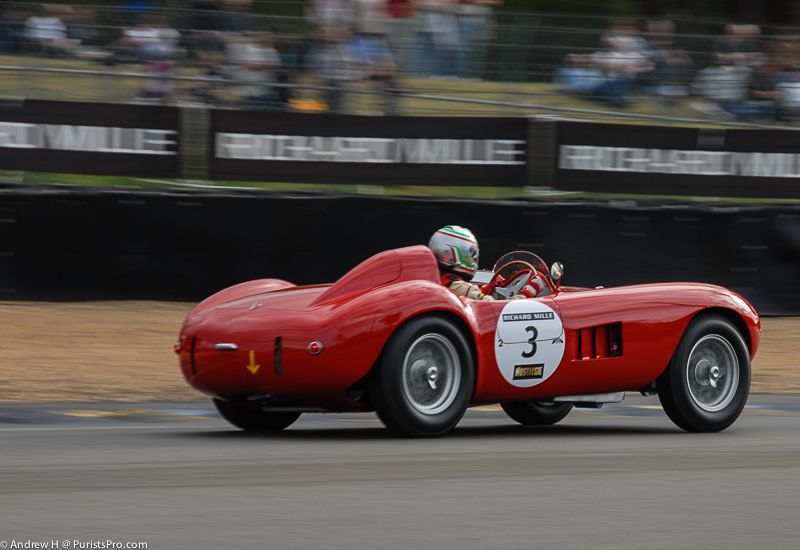
[The Maserati 300S accelerates out of the Mulsanne Corner]
Before this, the prevailing approach followed by automobile designers when defining a volume and shaping the shell of an automobile was to treat each part of the body as a separate, distinct element—a box to house the passengers, another for the motor, and headlights as appendages. In the Italian aesthetic, there are no sharp edges; the curves of the bodywork maintain the overall flow and unity, creating a sense of speed. The bodywork for such cars was more or less handcrafted, with its aluminum panels shaped over wooden forms. 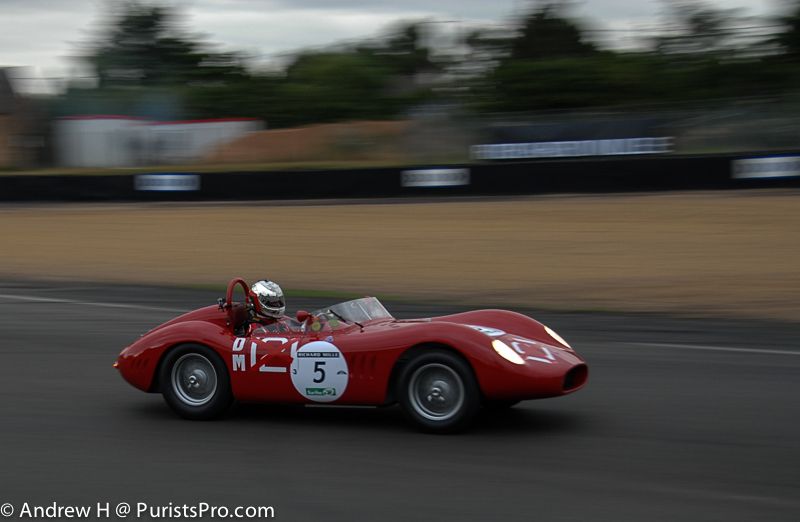
[At dusk: the incomparable Maserati 250S]
There is a nostalgic elegance to the cars. A time when as an enthusiastic and funded amateur could simply buy the car, qualify, and potentially win the Le Mans 24 Heures! The car exudes speed from its lines. It was daring and glamorous. Of the cars racing at the Le Mans Classic, there were two that stood out: the Fiat 8V and the Ferrari 250 GTO SWB.
The Fiat 8V name was the result of Ford having a copyright out on the V8 name. Designed by Luigi Rapi and developed by Dante Giacosa (who was responsible for most of the Fiat designs after the second World War), the 8V was originally thought of as a luxury sedan. Built between 1952 and 1954, the project lost at Fiat lost some of its original enthusiasm and the car ended up as a GT racer. For the early 1950’s the 8V was an impressive car; a top speed of 118 mph. Only 114 of the 8V’s were made. However, it was highly successful and won the Italian GT championship every year until 1959. Given the embarrassment of riches in the form of GT cars in the Italian car industry at that time, it was an impressive achievement by the Fiat 8V.
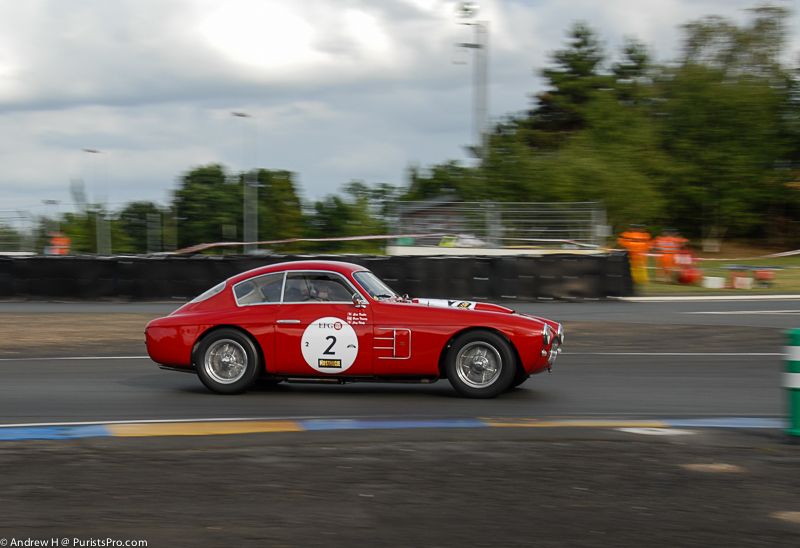
[The beautiful lines of the Fiat 8V Zagato]
The embarrassment of riches in the Italian car industry at that time included the most famous marque of all: Ferrari. And in 1959 Ferrari introduced one of its best GT racing cars of all time: the 250 GT Berlinetta SWB. Once again, only a limited number were ever made: 176 examples in total. It was, and remains (according to most polls) one of the best Ferraris ever made. It won Ferrari the 1961 GT Constructors Championship. A shorter wheelbase than the 250 GTO (and hence the SWB insignia), the car offered disc brakes for the first time, a low weight to high power ratio, and the suspension to match. The Ferrari 250 GT SWB was highly competitive and the consummate racing machine. 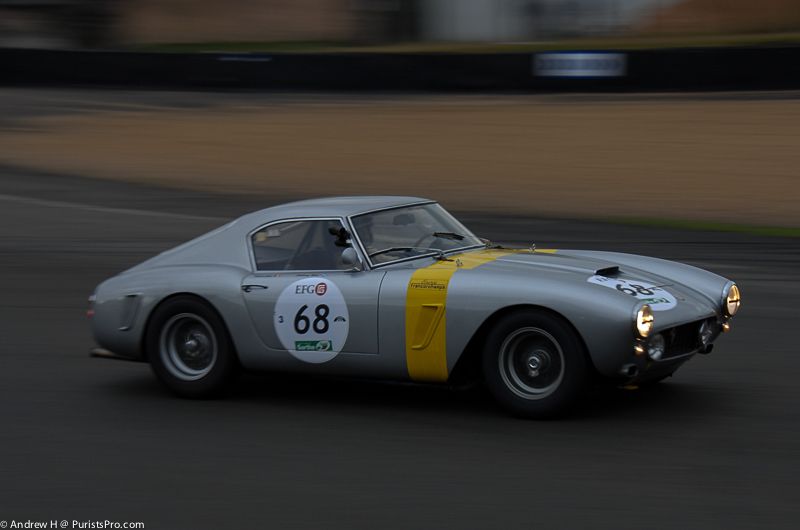
[The Ferrari 250GT Berlinetta at speed]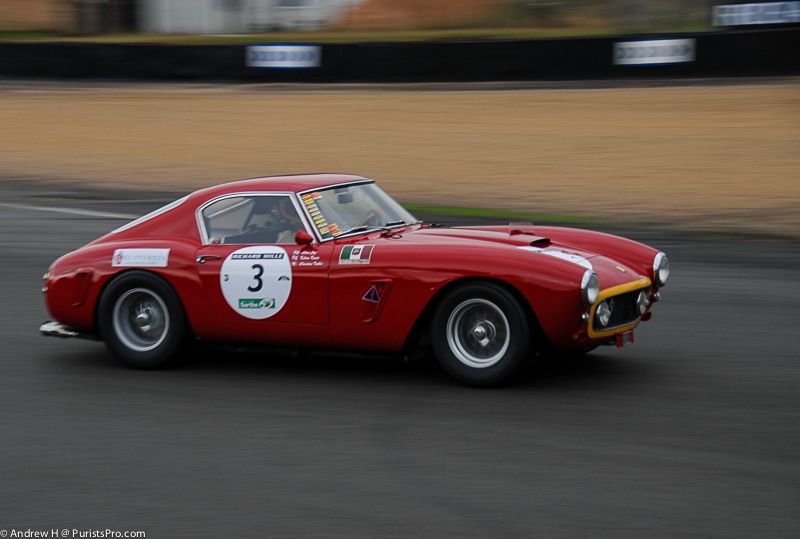
In the 1960’s there was a structural move to mid and rear engine cars, which at a stroke articulated a new aesthetic and function. While a number of car manufacturers were moving to the mid and rear engine cars for the Le Mans: notably Ferrari and Porsche, it was the outside manufacturer, the one the racing fraternity did not expect, that dominated the event for the decade: Ford. The Ford GT40 was the result of a deal gone sour. A fallout between Henry Ford and Enzo Ferrari over the possible acquisition and racing rights of the Ferrari team, Henry Ford then directed his racing division to build a car that was a Ferrari beater. Ford went in to partnership with Lola (that already used the Ford V8 engines) and designed the GT40 from a clean sheet of paper. Within a short space of time (only 3 years), the Ford GT40 went from an idea to victory at Le Mans in 1966. The car dominated the event for the remainder of the decade.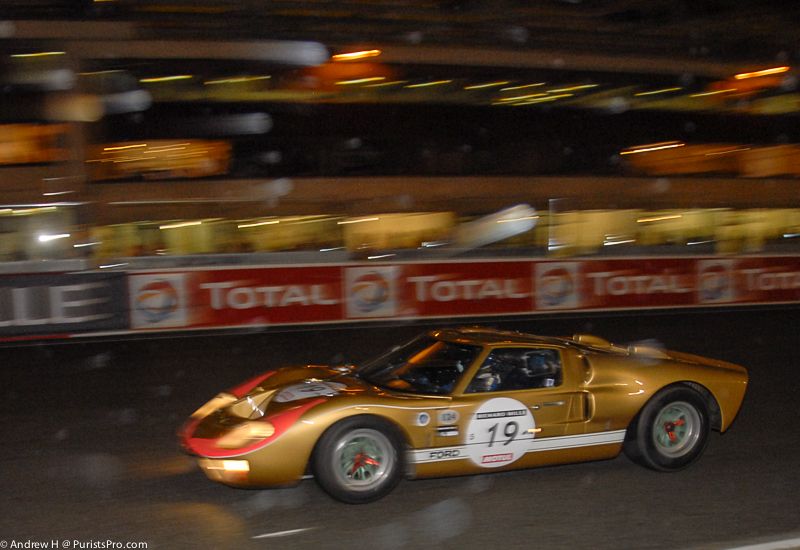
[A Ford GT40 MkIII drives through the rain at night]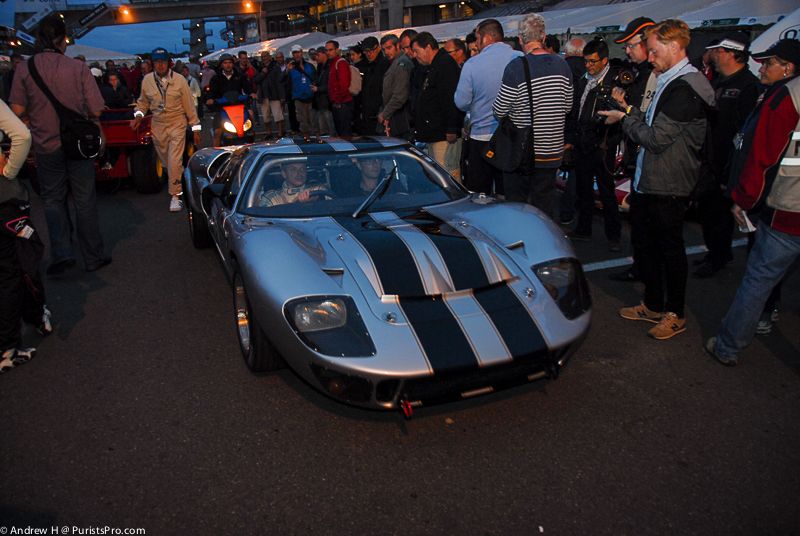
[Leaving the paddock area on the way to the track]
The advent of the 1970’s brought with it the domination of European teams again; but new names dominated the podium: Porsche and Matra-Simca. Cars were now of a ‘brute force’ design. Not so much designed by the individual, but a team effort that required the considerations of aerodynamics over individual design ideas. The move, about a decade earlier, to place the engine at the rear of the car allowed a more aerodynamic shape: a design that was now sculpted by reducing the airflow over the car. The Porsche 917 was the first of the “modern” Le Mans cars. The final 917 Le Mans winning design was a result of power determining the aerodynamics of the car. The final car shape was to allow the car to travel at high speed while keeping the car stable. Aesthetics were now concerned with expediency and efficiency as a racing machine.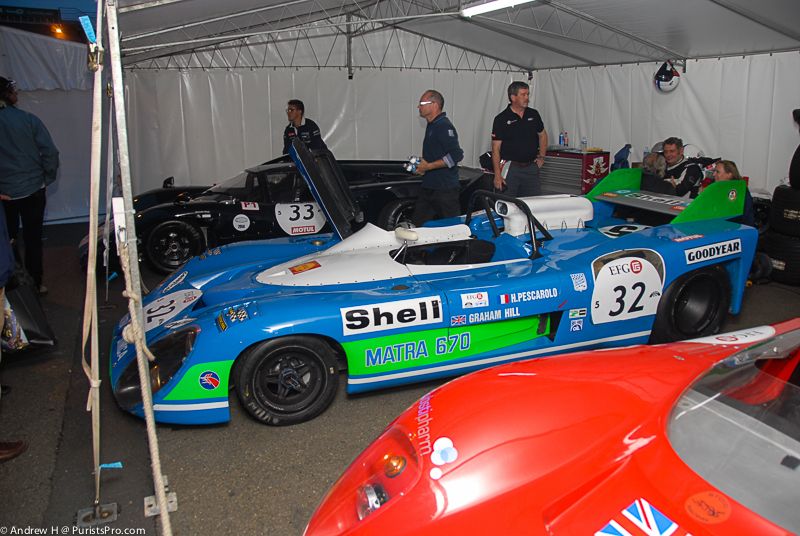
[Another Le Mans winning car: the Matra that brought victory for Graham Hill and Pescarolo in 1972]
With Richard on hand at the Le Mans Classic I had the chance to sit down with him and ask him about what the classic racing cars mean to him and how they have influenced him. Richard was, as ever, effusive about the subject matter. Over the years, Richard’s collection has grown and he now has a collection from around the same era: namely the late 1960’s and early 1970’s. The obvious question is why: why that particular era? To Richard, that era was the pinnacle of motor racing. He laughed quoting Jackie Stewart: in the 1970’s sex was safe, but motor racing was dangerous! Today it’s the opposite: sex is dangerous and motor racing is safe! For Richard, the 1970’s motor racing was a gladiatorial, it was epic, and it is, for him, a golden era of racing machine aesthetics.
Racing machines from the 1970’s were “magnificent” but “fragile” machines. They were both hand designed and hand made. The design for the car was started with a sketch: a pencil and a piece of paper. It was the result of a flight of the imagination. The fluidity in the shape of the car was the result of the drawn line, and not the computed line. Cars were designed with both the engine and the body shape in mind: engine and chassis had to be considered together to enhance the rigidity in the car: “… they are works of art!” Somewhat ‘tongue in cheek’ Richard compared todays cars with plastic surgery: if everyone went to the same plastic surgeon for a surgery on the face: we would all look the same! Take the paint off most modern cars and you would find it difficult to tell them apart (excepting a few individuals who are enthusiasts in the area). That is to say that Richard does not admire the technology and techniques in modern racing. On the contrary, he finds such subject matter fascinating: but it’s the design, the aesthetics of the car that is missing. The design is shaped by the computer and the wind tunnel; not by an individual’s imagination.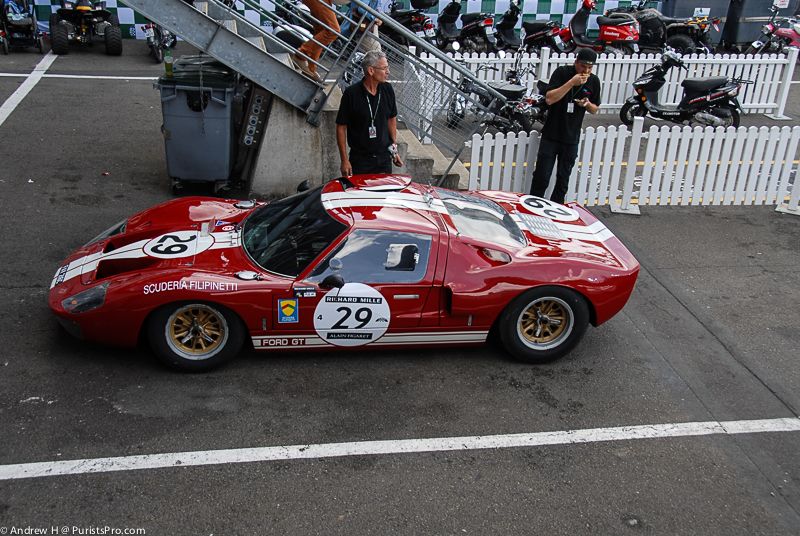
[Ford GT40 Mk I (No 29). Waits to enter the pits area. Note the design lines: the flow from the nose of the car to the rear]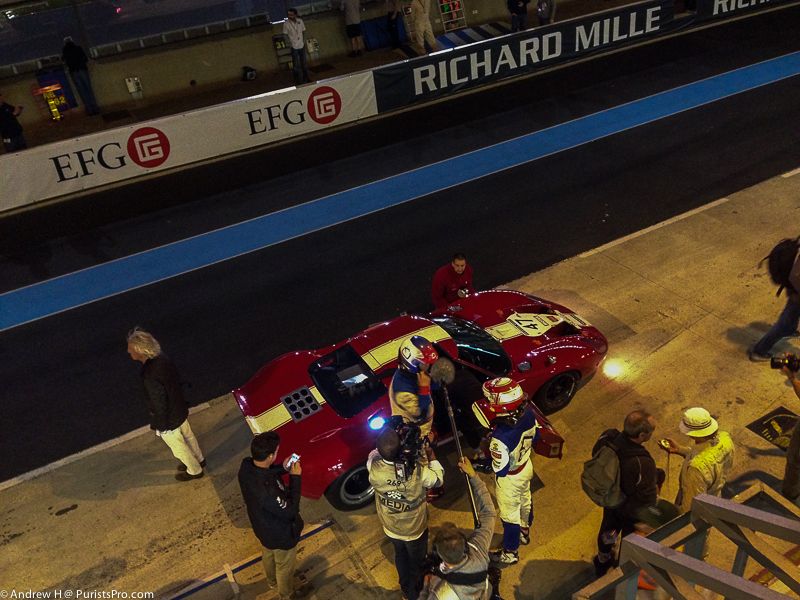
So Richard draws inspiration from the two worlds: the approach to the aesthetics of the racing machines from the 1970’s and the technology and techniques from today. From yesteryear: the pencil and the drawing board, the line of the imagination drawn from a blank sheet of paper. Even now Richard will sketch a new design: “.. the only way to emphasize the artistic dimension.” He did it for his first watch: the RM001. I have seen the sketches for the RM039 (the most complex watch he has designed). Watch and movement are designed together, from the start, for beauty, for aesthetics, as a work of art! But from the present day racing machines, Richard develops the aesthetics with the new technology and techniques that enable the implementation of new forms and new materials. Richard Mille watches truly are the best of both racing worlds!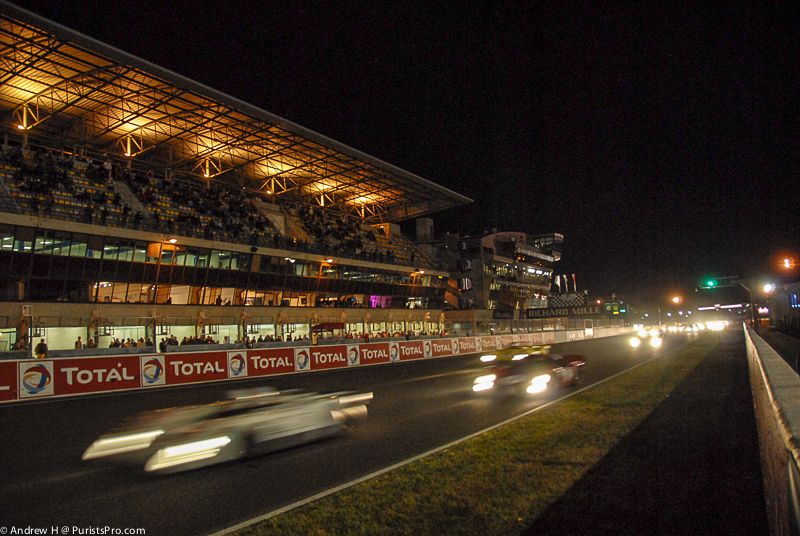
[The 1970’s Le Mans cars thunder down the finishing straight at night.]
So out of all the racing machine wonders on show at the Le Mans Classic, was there one car out there that Richard thought was the aesthetic definition of a racing car at the Le Mans Classic? For Richard, the car where the aesthetics were incredible, where the volumes on the car and the mechanical details were perfect was the Ferrari 312P. For Richard, it is always an emotional response. The car was not the most successful race car: it had limited success in 1969 (the first year it raced), and even less success in 1970 (the last year it raced). But for Richard, aesthetically the car is a work of art: the aerodynamics are fluid and were drawn. 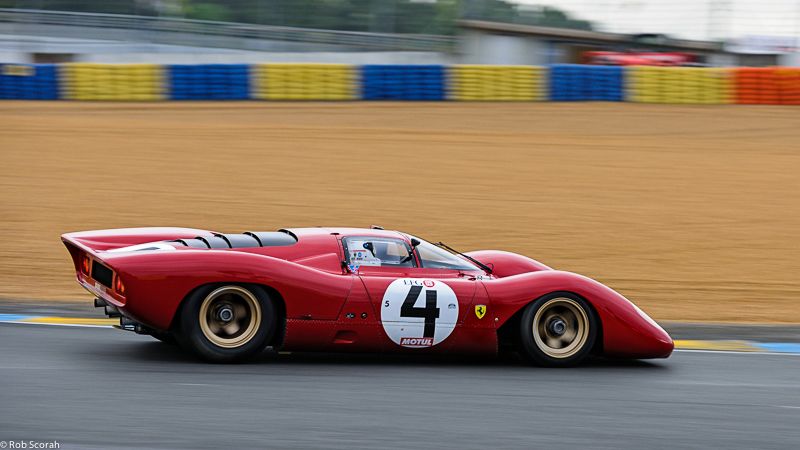
The Ferrari 312P was a car that could have been successful. It was developed at a time when Ferrari was bought by Fiat and initially resources were not dedicated to the race team. At the 1970 Le Mans 24 Heures, when the Porsche 917 came in first, the Ferrari 312P was one of the few cars to finish the race. Had Ferrari committed more resources it was possible that the 312P might have had a more illustrious history. For a time, once again, at the Le Mans Classic, the car gets to race against the Porsche and Lola once again.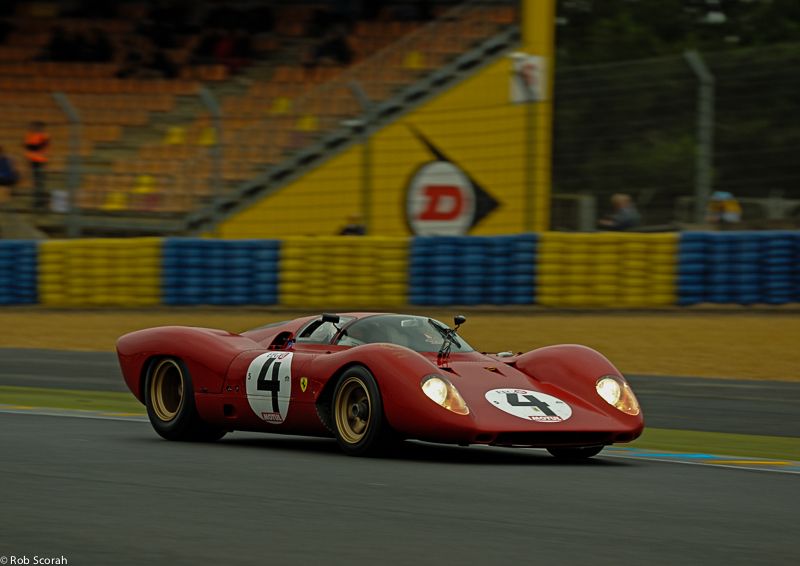
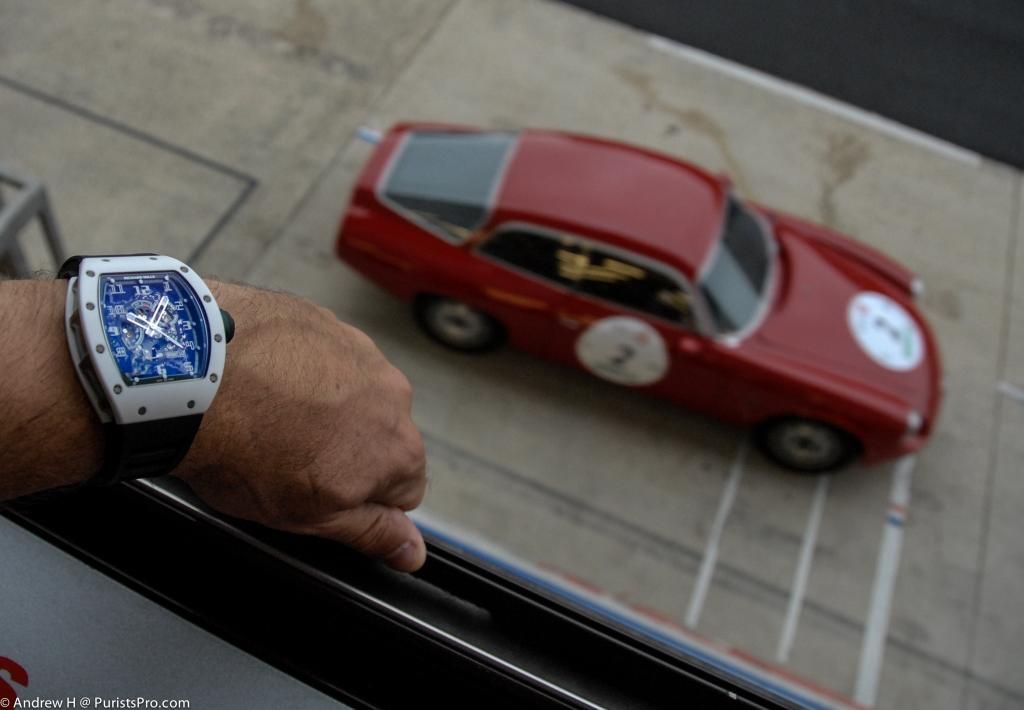
[Racing machines designed and finished by hand: the Richard Mille Le Mans Classic RM030 and the Alfa Romeo Giulietta SZT]
Andrew H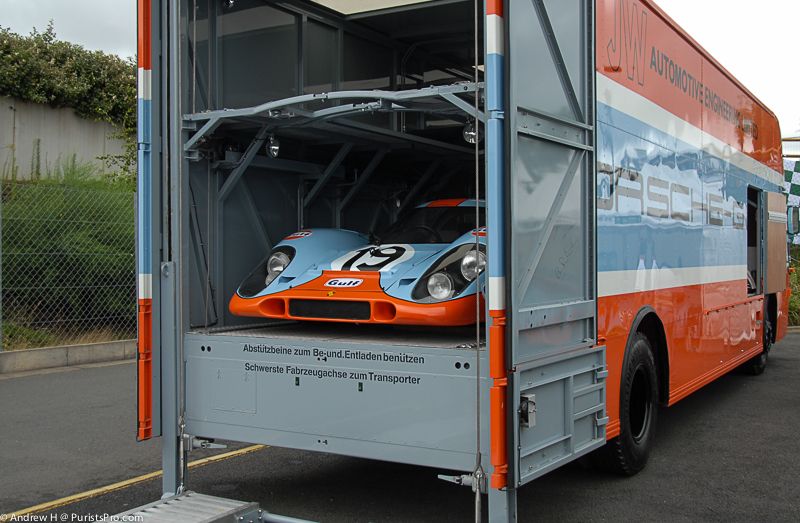
[Until next time…. In 2016!] This message has been edited by 219 on 2014-10-05 11:49:26 This message has been edited by AnthonyTsai on 2014-11-04 07:51:36

Aesthetics and the Racing Machine! A celebration at the Richard Mille Le Mans Classic!

Superb report Andrew...

Thanks Fx - and yes - you are right! The particular Richard Mille

great report, thank you so much...


Great Report Andrew...

Fascination for machines

